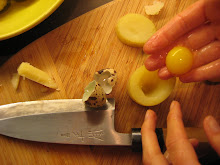At the center of Windrose Farm in Paso Robles, California, you will find an enormous Oak. Every so often, an acorn will drop from the tree, requiring that any farmer or visitor perusing the property wear a sturdy, wide-brimmed hat for protection. If you aren’t wearing one, you will be inevitably struck, and Farmer Bill gets a kick out of it every time. He’s also quick to take it as an opportunity for an ecology lesson: “Now, where do you suppose those acorns come from?” David and I both erroneously assumed that the acorns fall from the tree branches as a means of reproduction, like any other tree would spread its seed. But that would be too obvious, and upon arriving at Windrose one realizes that there’s nothing obvious or ordinary about it.
Farmer Bill explains: “Those acorns are little bullets! The birds are hunting for worms! The woodpeckers make a hole in the trunk, stick an acorn inside, and when they come back later, they find worms munchin’ away on the acorn, which means worms for dinner! Now, that’s clever.” Bill smiles to himself and gazes up at the oak, taking true delight in the micro-ecosystem’s natural intelligence.
Last year SummerWinter arranged for Windrose Farm to raise a lamb for supper club with the intention of educating ourselves, as well as our guests, about the process of a lamb slaughter from start to finish. We wanted to learn everything about the animal leading up to the actual cooking—the land, farmers, and slaughtering itself. Once the lamb was air-cured for a week or so, David broke down the animal himself before preparing it several different ways for a supper club event back in October.
Barbara and Bill were incredibly hospitable. Upon our arrival, we were invited into their home and offered Bill’s Tractor Bread, the famous loaf he bakes himself. Every day Farmer Bill kneads his dough on an old butcher’s block that sits in the center of his modest kitchen, which is lined with countless treasured cookbooks. After our small morning snack, Bill showed us a Native American stone mortar and pestle he had found on the property. Up until 1930,Windrose Farm was inhabited by the Salinan Native Americans who hunted and gathered on the Central Californian land. They would break open the acorns with a small stone and place them in the sun to dry. Once dried, they were pounded in a stone mortar until a fine flour was obtained which could be used for acorn mush soup or bread. Clever and practical, just like those woodpeckers.
As opposed to the privileged choice we are given to eat locally today, this kind of sustenance was not an optional course of action. It was simply the relationship shared by the Salinan people with the land based on locale. Wherever you are, eat what’s available, when available. This instills an intrinsic respect for the land, which Bill and Barbara have worked hard to maintain and establish as a founding principle of Windrose Farm. When it comes to farming, they subscribe to a biodynamic philosophy. In short, “that the farm should be seen as an ecosystem in its own right, and that our striving should be to move towards building and maintaining plant and animal communities, which are ecologically suited to its unique combination of soil, climate and place." Ultimately, they would like to create a self-sustaining farm that relies on no outside source materials. That’s the intention, and every day they get a little closer to this goal. Thank you, Barbara, Bill, and Windrose Farm!
We are hoping for a SummerWinter supper on the farm come SPRING. Stay tuned and jump on the wagon!

















